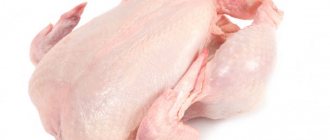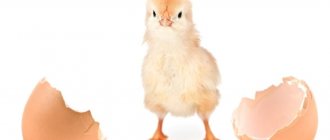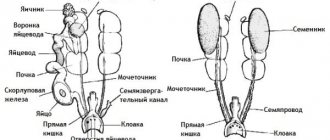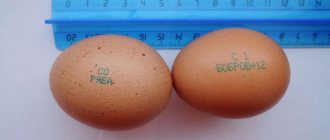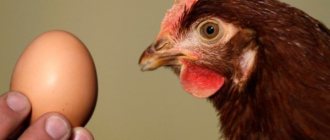When you go shopping in a supermarket, on the shelves with eggs you can find different categories, which differ in price. How are these eggs different? How are they divided into categories and which category of chicken eggs is better? Questions that every buyer will answer. Let's try to understand this topic.
Product containing “sun” (vitamin “D”)
What other markings could there be for eggs?
The letter “D” may be indicated on the packaging and shell. This marking indicates a dietary egg. This is not a special variety, but simply very fresh eggs that are not stored at subzero temperatures and are sold within seven days. After this period, dietary eggs become table eggs. Typically, diet eggs are stamped with a red stamp, and table eggs are stamped with a blue stamp.
Read also: 9 ways to put on lipstick
Question and answer Why are eggs difficult to peel?
The packaging of imported eggs also indicates the class of the product and its weight category. So, the letter “S” means that the egg weight is less than 53 g, “M” - 53-63 g, “L” - 63-73 g and “XL” - 73 g or more. The first digit of the number on the package indicates in which EU country the eggs were packed. Most often this is Belgium (number 1), Germany (2), France (3) or Holland (6).
Imported eggs also indicate the conditions in which the chicken was kept. So, the number 3 means that the chicken was in a cage, 2 - in the chicken coop with the ability to move around it, but without permission to go out into the yard, 1 - the chicken that laid the egg lived in the chicken coop and was released to walk in the open air, some believe that the eggs Such hens are healthier. The number 0 marks eggs belonging to the category of organic products, which are much more expensive than usual and have additional quality certificates.
The best domestic incubators
Incubator “Cinderella” IN 45/220V with manual rotation
Capacity – 45 pcs. Power – 50W. Maintaining the required temperature with an error of 0.20C. Manual turning for even heating. The instruction manual supplied with the product should be strictly followed to produce healthy, strong chicks.
Price: about 2000 rub.
“Cinderella” IN 45/220V - an economical option for hatching chickens
Incubator for eggs "Laying hen" for 104 pcs., automatic
Fully automatic control allows you to automatically control the temperature and control the humidity value, thanks to the presence of an ultrasonic sensor.
If the power suddenly goes out, it switches to a backup power supply of 12 V, and when connected, it returns to the main one.
Turns over automatically after a set period of time. If there is a problem with operation, the red lamp on the control unit lights up.
2 fans inside the incubator ensure uniform heating. In addition to the product, you can order cells for goose, duck, or increase the number of chicken.
The manufacturer provides warranty service for 24 months.
Price: 7300 rub.
"Laying hen" operates in automatic mode
Incubator “Cinderella” IN 98/220V with automatic rotation
Capacity – 98 pcs. Power – 75W. The incubator is equipped with an automatic revolution of all eggs placed in it. Additionally, the kit includes 2 grilles. The operating instructions supplied with the product by the manufacturer must be strictly followed.
Price: about 4000 rub.
Fully automatic incubator
Egg weight by category: table
Further in the text there is information about how much an egg of category 1, category 2, etc. weighs. The given weight is for one unit.
| Category | Weight with shell, g | Weight without shell, g |
| Third | 35-44,9 | 32-40 |
| Second | 45-54,9 | 40-50 |
| First | 55-64,9 | 50-59 |
| Selective | 65-74,9 | 59-68 |
| Higher | From 75 | From 68 |
In GOST, such a table is wider; it is supplemented with information about the weight of a dozen and a package of 360 pcs. products.
Description of categories
The eggs of turkeys, guinea fowl, quail and ostriches are not divided into groups depending on weight. For them, only the lower limit of this indicator is set.
Chicken embryos are divided into 5 categories.
Categories of chicken eggs
Its price depends on the category of the product.
- The largest options belong to the highest category - DV, SV, their weight should be at least 75 g.
- Selected products - DO, CO/c0 weigh from 65 to 74.9 g.
- The mark of the first category - D1, C1 is placed on the shell of specimens weighing 55-64.9 g.
- Eggs of the second category - D2, C2 weigh from 45 to 54.9 g.
- The third category is D3, C3 includes the smallest eggs weighing 35-44.9 g.
On a note! In culinary recipes, one egg is taken to be an egg weighing about 40 g.
What weight should eggs of other farm birds have?
The minimum permissible weight of eggs of other farm birds, in addition to chickens, is also stipulated by law.
Table No. 3
Product size depending on type:
| Product type | Minimum mass, g |
| Ostrich | 650 |
| Turkey | 60 |
| Caesars | 36 |
| Quail | 10 |
Source: regulatory documents of the Russian Federation.
Signs of quality eggs
High-quality chicken treasures should be clean (no feathers or droppings), no cracks, and consistent in size and weight. Each egg must have a stamp and marking on it. This allows you to find out the category of eggs and their maximum shelf life.
The shell of a fresh egg should have a matte, not glossy color. If you place a fresh egg to your ear and shake it, you should not hear any sounds (gurgling). If the egg is too light, this may mean that it has already dried out and may be rotten.
Description of species
Food eggs of any farm birds form two groups:
- dietary;
- dining rooms
The type is determined by the shelf life.
Table No. 2
Shelf life of table and diet eggs:
| type of product | Allowable storage time, days |
| Dietary | |
| chicken | 7 |
| turkey | 7 |
| quail | 11 |
| guinea fowl | 30 |
| ostrich | 10 |
| Dining rooms | |
| chicken | 25 |
| turkey | 25 |
| quail | 30 |
| guinea fowl | 90 |
| ostrich | 30 |
Source: regulatory documents of the Russian Federation.
What are the benefits of diet eggs?
A dietary product differs from a table product only in storage time.
They are taken into account every day at a temperature of 0-20 °C, not counting the date of birth of the embryo.
From the point of view of nutritionists, fresh germs are healthier because they retain everything:
- vitamins;
- minerals;
- enzymes.
Over time, the shell loses:
- protective shell;
- her pores open;
- the internal contents are exposed to aggressive influences from the external environment.
The first to begin to break down are tocopherol derivatives, adermin, cobalamin - vitamins E, B6, B12.
Decreased enzyme activity:
- impairs the digestibility of the product;
- it becomes less protected from attack by pathogens from the outside.
Dietary proteins are better suited for making pies, soufflés, and biscuits, as they quickly form a fluffy foam when whipped.
When checking with an ovoscope in a store or at home, it is clear that:
- the yolks of absolutely fresh eggs are motionless;
- remain in the center even with active rotation;
- the air chamber occupies no more than 4 mm in height.
Requirements for table eggs
Table products differ from dietary products in their long shelf life.
- They can be placed at temperatures from -2 to 20 °C.
- If it does not rise above 0 °C, then the shelf life increases to 3 months.
Yolks of shelf-stable products can:
- lose immobility, as the tension of the protein cords holding them in the center weakens;
- The air chamber increases in size over time to 7-9 mm.
What are the types and categories of eggs?
Categories of eggs
Egg products are divided into two large groups (types of eggs):
- Dietary , designated by the letter “D” in red. According to established standards, they have a shelf life of up to 7 days. The shell must be clean, only small specks are allowed. Storage temperature - not lower than 0. The white is dense, the yolk is evenly colored.
- Dining rooms that are about blue. Products with this marking can be stored at room temperature for up to 25 days, in refrigerators for up to 90 days. Their yolk is mobile, the white has a low density.
Based on weight, testicles are divided into 5 categories:
Read also: UNITED NATIONS (UN)
| Category | Weight, in grams |
| B - highest | From 75 and more |
| O - selected | 65-74,9 |
| C1 - first | 55-64,9 |
| C2 - second | 45-54,9 |
| C3 - third | 35-44,9 |
Types of incubators
Incubators are electrical devices that are used to hatch chicks.
There are household (simultaneous use of 10÷250 pcs.), for farms (250÷2500 pcs.) and industrial (from 2500 pcs.).
Hand incubators
Hand incubators are used by rural residents to hatch chicks for themselves. Small capacity up to 250 pcs. Manual temperature adjustment. The eggs are also turned by hand to ensure even heating.
Automatic incubators
Divided into types:
- Rolls automatically. They use tray movement.
- Turning masonry over by rotating on rollers.
- The tilt of the trays is no more than 450.
- With a thermostat: analog, which maintains the set temperature regime, and digital, which automatically regulates the temperature, changes the humidity in the incubator, and gives the command to turn the trays.
What is the difference between dietary, table and small chicken eggs?
Chicken eggs should be sorted into dietary, table and small . Dietary include eggs that have a clean and strong shell, a fixed egg no larger than 4 mm in size, a strong, barely noticeable yolk that occupies a central position in the egg and an invisible germinal disc. The mass of such eggs must be at least 58 g (1st category) or at least 44 g (2nd category). Table eggs are also divided into 2 categories: the 1st includes eggs with a clean, strong and whole shell, a fixed air chamber. The yolk of such eggs is strong, inconspicuous, occupying a central position in the egg, the white is dense, translucent, the height of the puga is not more than 11 mm, the weight of one egg is not less than 47 g; Category 2 includes eggs with a clean, strong and whole shell, slight contamination in the form of individual dots is allowed, the shell moves easily and can have a height of up to 13 mm, the yolk is weakened, clearly visible when the egg is scanned, the weight of one egg is not less than 43 g Chicken eggs that have all the indicators of good quality, but weighing less than 43 g, are defined as small .
Dietary eggs are stored at temperatures from 0 to 20 °C - 7 days; dining rooms - at a temperature not higher than 20 ° C - 25 days, at a temperature from 0 to 2 ° C - no more than 120 days. If the shell is contaminated, the shelf life of eggs is significantly reduced.
Foreign incubators
Automatic incubator Sititek-112
The incubator has a built-in thermostat, automatic turning 112 pcs.
The main power supply is 220V, there is a built-in 12V battery (in case of a power outage).
The thermostat maintains the desired temperature range with an error of 0.10C. The hygrometer continuously monitors humidity levels.
The stand provides a stable position for the eggs placed on it. There is a special recess for evaporating water.
The product kit includes an ovoscope, which determines the condition of the eggs without removing them from the incubator.
Price: 10500 rub.
Sititek-112 – will allow you to hatch healthy chicks
Incubator HHD-32 with LCD display, LED backlight
Capacity – 32 pcs. Automatically maintains the desired temperature and turns trays at a set interval.
Equipped with a transparent lid that allows you to observe the hatching process. The ventilation system evenly distributes the heat flow between the cells. If the parameters deviate from the specified ones, the device will notify you with a sound signal.
Price: 5600 rub.
The transparent cover of the HHD-32 allows you to observe the removal
Other designations
Additional symbols are designed to attract the attention of the consumer.
The trend to choose healthy foods is driven by the fashion for a healthy lifestyle. Today, manufacturers adjust ordinary products to fit it, using tricks that are invisible to the gullible buyer.
Village products in the store
Supermarkets work only with large suppliers who are able to pay decently for advantageous shelf space and provide the required volumes of products.
The attractive name “Village”, accompanied by a picture of chickens peacefully walking on a green field, is purely a marketing ploy.
Environmental friendliness
Eco-labeling is only possible for products whose production meets strict international and national requirements.
The oldest signs on the market indicate an increased level of product safety for the environment, but not all of them are used for food products.
These include:
- "Ecosign", European Union;
- "Blue Angel", Germany;
- "Environmental Choice", Canada;
- "White Swan", Scandinavian countries;
- "Eco-sign", Japan.
There is no unified eco-labeling system in Russia. Analogues of European variations are the icons: “Eco”; "Bio" The legality of their use in most cases remains on the conscience of the manufacturer.
In theory, such labeling should mean that the product is produced without the use of pesticides, hormones, fertilizers and growth stimulants.
The use of GMOs and any veterinary drugs, including antibiotics and vitamins, is also excluded.
Raising poultry to obtain such an egg is required in regions that are not exposed to high doses of radiation and free from other contamination.
The prefix “bio” means that laying hens should roam freely around the pasture without lack of natural feed.
A dozen eggs obtained under such conditions cost disproportionately more than usual. Whether to trust labels for similar products sold at average prices is an open question.
Saving
Now let's move on to the financial side of the issue. Our average store price for eggs is as follows:
- Second category: 53 rubles per ten.
- First category: 59 rubles per dozen.
- Selected: 63 rubles per dozen.
First, let's calculate the cost of 1 gram of egg for each category.
- Second category: 53 ÷ 509 = 0.1041 rubles per gram.
- First category: 59 ÷ 595 = 0.0992 rubles per gram.
- Selected: 63 ÷ 665 = 0.0947 rubles per gram.
As you can see, a gram of selected eggs is the cheapest, but very often people try to save money and take the second category of eggs, because they seem to be the cheapest. In fact, it is most profitable to take selection. It may be more expensive, but in relation to the resulting mass of product, selection is the most profitable.
Now let's do the recalculation in a more visual form. We will rely on the second category. Let us denote the average actual mass of an egg of the second category as x.
Then the average actual mass of an egg of the first category relative to the second will be 59.5 ÷ 50.6 = 1.17x. This means that the price of a dozen should be 1.17 × 53 = 62.01 rubles. But in practice, a dozen of these eggs cost only 59 rubles.
The average actual weight of a selected egg relative to the second category is 66.5 ÷ 50.6 = 1.3x. This means that the price per dozen should be 1.3 × 53 = 68.9 rubles. But in practice it’s only 63 rubles.
Chemical composition and beneficial properties of the product
The egg contains vitamins, microelements, amino acids, and other beneficial substances. The yolk has the most valuable supply of nutrients, because its purpose is to provide the embryo with everything necessary for development.
The egg contains vitamins, microelements, amino acids, and other beneficial substances
Structure of a chicken egg:
- Yolk. Occupies approximately 1/3 of the total volume of the testicle. It can be of different shades - from yellow to orange, the color does not affect the chemical composition.
- Protein . Liquid occupying 2/3 of the volume of the testicle. It is transparent and heterogeneous. Here is a cord, resembling an umbilical cord, that holds the yolk in the center.
- Air chamber. It is located on the blunt side of the egg, between the shells. When the product is fresh, its volume is minimal; during storage it gradually increases.
- Shell. It comes in different colors (white or cream), and there are breeds of chickens that lay eggs with brown, greenish, and bluish shells. It has tiny pores that provide air exchange with the internal contents of the testicle.
Top 5 quality products based on the results of test purchases of Roskontrol
Having familiarized yourself with consumer opinion regarding the products of the segment in question, it would not hurt to study the verdicts of the independent examination of Roskontrol, which can tell much more useful information. It is important to remember that only laboratory testing can determine the true quality of any product, including chicken eggs.
Roscar Extra Omega-3 Active C0
Price – 99 rub. for 6 pcs.
The best, according to experts, are eggs of the highest category, the composition of which was recognized as completely safe, not including antibiotics, pathogenic microflora and GMOs. You can eat it raw, especially considering that eggs are rich in Omega-3 fatty acids, the volume of which fully corresponds to what is stated in the labeling.
very tasty and healthy eggs, fully consistent with the characteristics indicated by the manufacturer himself;
always fresh, clean products;
The quality of the packaging is beyond praise.
exorbitant price.
Okskoye S1
Price – 73-110 rub. for 10 pcs.
Despite the fact that these are category 1 eggs, they were highly rated by the expert commission. Thus, among the numerous advantages of the product, experts noted the high degree of safety of eggs, in the composition of which it was not possible to identify even a hint of anything prohibited, excellent organoleptic properties and a relatively low height of the air chamber, if a comparative analogy is made with analogue samples from other manufacturers.
taste qualities;
safety;
indicators of taste and energy value;
size close to the upper threshold value.
not identified.
Roscar Activita, selenium + iodine, C0
Price – 97 rub. for 10 pcs.
Another high-quality eggs of the highest category, which received a high examination score, being recognized as tasty and completely safe, containing no antibiotics or pesticides.
large fresh tasty eggs with good composition;
high content of useful chemical elements (selenium and iodine);
appearance and quality of packaging.
not the most affordable price tag.
Every day C0
Price – 44 rub. for 10 pcs.
If all the previous positions seem too expensive to you, then take a closer look at the “Every Day” eggs, which have rightfully become the most budget-friendly in the ranking. At the same time, this circumstance did not in any way affect the quality of the product, which overall satisfied the expert commission. Thus, eggs were recognized as safe, tasty and nutritious, since their yolk content was very high.
good taste characteristics;
the air chamber is smaller than many analogues;
very economical offer.
non-compliance of Omega-3 and Omega-6 indicators with current GOST;
there are specimens with shell notches;
Not the best quality packaging.
Shelf life of chicken eggs: raw, boiled and in the refrigerator
Eggs in their shells should not be placed in the freezer.
The storage duration is influenced by the following factors:
- Origin of the product. Poultry farm products are stamped with a date - the shelf life is calculated from it (no more than a month). Eggs from domestic hens, if you are confident in their quality and in suitable conditions, can be stored for up to 3 months.
- Storage conditions . Temperature, air humidity, and other factors (absorption of foreign odors) influence. These products last the longest in the refrigerator.
- Shell integrity. Raw eggs with intact shells last longer. In the refrigerator - a month, at room temperature - up to 20 days from the production date, with a cracked shell - up to 2 days.
- Cooking method . Boiled eggs are stored much shorter and only in the refrigerator. Hard-boiled - no more than 14 days, soft-boiled - up to 2 days, cracked hard-boiled - up to 4 days, peeled hard-boiled - up to 3 days.
Attention! Eggs in their shells cannot be placed in the freezer; only the separated yolks are stored this way.
How to protect yourself from salmonella
Not only do we love eggs, but also the causative agent of a serious infectious disease - the salmonella bacterium. Protecting yourself from this uninvited guest is not so difficult.
- Dirt and dried droppings on the shell are not a sign of an “organic” egg; rather, they indicate insufficient hygiene in the poultry farm.
- Eggs with damaged shells should not be eaten.
- Before use, the egg should be washed under running water and soap. Remember to wash your hands, even if you just touched the egg.
- Store eggs in a cool, but not too dry place, away from strong-smelling foods and raw meat; the best temperature is 0–5 °C.
- Eggs can be pasteurized. To pasteurize, they are washed and then separated into sterilized containers. After combining the yolks with the whites, they are filtered and heated to +63 ° C for one minute, then quickly cooled.
Requirements according to GOST
According to the current GOST in the country, all categories of eggs produced by poultry farms for sale must meet the following requirements:
- whole, clean shell without inclusions;
- without foreign inclusions in the light;
- without smell;
- no moisture on the surface;
- on the ovoscope: the air chamber is motionless, the white is dense, transparent, the yolk is strong, barely noticeable, without a clear boundary, slightly mobile;
- have the marking and correspond to it;
- if processing was carried out, there must be an appropriate mark (1 - without treatment, 2 - chilled (stored at -20...0 °C), 3 - chilled (stored at 0-5 °C), 4 - processed for the purpose of preservation);
- lumpy materials that comply with regulatory documents are used as packaging (safe, intact, dry, odorless);
- one package must contain eggs of the same type and the same production date;
- the labeling on the packaging must correspond to the packaged product;
- containers that have already been used must be disinfected in accordance with regulations.
Labeling requirements
Russia uses a unified system for labeling food eggs of all land poultry, including:
- chickens;
- turkeys;
- guinea fowl;
- quail;
- ostriches.
The rules are regulated by state standards dated January 1, 2014:
- GOST 31654-2012 - for chicken products;
- GOST 31655-2012 - for all other types.
Interstate standards were developed by specialists from specialized institutions:
- State Scientific Institution “All-Russian Research and Technological Institute of Poultry Farming”;
- NO "Rosptitsesoyuz"
Belarus, Kyrgyzstan, and Moldova voted for the adoption of the document regarding chicken eggs.
The list of countries where the Technical Conditions for Other Species are in force also includes Armenia and Kazakhstan.
What do the regulations say?
Markings are made using markers that are approved for use in contact with food and do not reduce the quality of the product.
The characters must be:
- clear, easy to read;
- not less than 3 mm in height;
- applied by spraying and stamping methods.
Other marking techniques are permitted if they provide sufficient clarity of the symbols.
The specified requirements apply only to those values that must be present on the shell:
- sorting dates, names, categories for dietary products;
- names and categories for table eggs.
Table No. 1
Explanation of the labels used for marking poultry eggs:
| Symbol | What does it mean |
| View | |
| D | Dietary product |
| WITH | table egg |
| Category | |
| IN | Higher |
| ABOUT | Selective |
| 1 | First |
| 2 | Second |
| 3 | Third |
Source: regulatory documents of the Russian Federation.
Sorting, labeling and packaging of the product is carried out within 24 hours from the moment of demolition. Diet eggs are marked with red paint, table eggs with blue paint.
Note!
- Marking is not applied to the shell if the packaging contains a label containing information required by law.
- When opening the container, such a sticker should be noticeably damaged to prevent the product from being replaced.
What else can the shell “tell” about?
It is also possible to put other information on the shell, although usually the manufacturer is limited to advertising on the packaging.
Percentage ratio of egg components
GOSTs allow printing here:
- farm name;
- trademark.
Which eggs to choose
- Table eggs of any size do not differ in nutritional value or nutrient content.
- The dietary, freshest options have an advantage.
- You can choose the type of product at your discretion.
Contrary to popular belief, the color of the shell does not affect the quality of the product.
- Poultry farms use productive crosses of egg-laying chickens. Some of them carry embryos with a brown shell, others with a white shell.
- There are breeds that produce embryos with bluish or green shells. Some of them are indeed more useful, but not because of color, but as a result of physiology.
Composition of eggs
Such birds, for example, ukheiliyu, cannot “boast” of high productivity.
The eggs of Chinese silk chickens have a cream-colored shell and also have a high content of:
- vitamins;
- microelements;
- other beneficial nutrients.
What to do if there is no marking on the shell
The absence of marks on the shell or a special label on the packaging is not permitted by law.
- Eggs without markings or packaging features can only be sold in markets.
- Private farmsteads and farms must have a certificate from a veterinarian confirming the health of the bird and the safety of the product.
How to distinguish a real country egg from a fake
The ability to buy good eggs is usually determined by the presence of trusted farms nearby. Their replacement with a cheaper product from the store can be detected based on the following signs:
- same size - domestic eggs are always heterogeneous in shape and volume;
- yolk color - rich yellow or orange in summer, becomes whitish in winter;
- The shell has a special difference - increased “roughness”, noticeable to an unprepared consumer.
The shelf life of such eggs remains normal, determined by the Technical Specifications. It is also necessary to pay attention to the contamination of the shell relative to its surface area.
If there is contamination in excess of 50% of the surface, wash the eggs with laundry soap under running warm water, or using special means.
In this case, the shelf life of the product drops to 12 days.
Functional foods: eggs with iodine and carotenoids
Well, okay, in which basket should we put a variety of “smart” eggs with iodine, “village” eggs with carotenoids, “fitness” eggs with selenium, “vitamin” eggs with a high content of acids? Let's try it in the cart labeled “ functional foods .”
According to the manufacturers, their place is there. Functional (or fortified) are products that have had their nutritional value increased or restored. In our case, the enrichment of eggs with various additives is carried out by adding appropriate preparations to the feed of laying hens. Manufacturers may call this “creating products with specified properties.”
Nutritionists do not have a common opinion about the effect of such products on the body, and our bodies are different: one benefits from iodine or acid, while another means death. We can only conclude that in this case the egg cannot be both “functional” and “organic”.
How to Determine the Freshness of Eggs by Dipping Them in Water
One of the most accessible is placing the eggs in a container with cool water:
- the fresh one will lie flat on its side on the bottom;
- when it is a week old, the blunt end will be slightly raised;
- in a perpendicular position at the very bottom - a period of 2 weeks;
- upon surfacing, it is rotten.
Important! If the white of a boiled egg has a grayish or bluish tint, then it should be thrown away. It is unsafe for humans to consume such a product.
Total
It turns out that by buying selection instead of the second category, we save 68.9 − 63 = 5.9 rubles from every ten eggs.
I do strength sports, and it is important for me to meet my daily protein requirement, which, by the way, is at least 1.7 grams per kilogram of body weight per day. With this calculation, even 10 eggs eaten per day will not solve the problem of protein deficiency, and therefore the more one egg, the better.
Let's see how much I'll save if I buy a dozen choice eggs every day for a year instead of the second category.
5.9 × 365 = 2,153.5 rubles in savings per year. Not bad!
Criteria for choosing eggs in a store
Appearance. The shell must be clean, without many foreign inclusions or chips. It is desirable that the surface be matte, otherwise it may be a sign of staleness. If there are eggs on the shelf with dirty shells or cracks, also refuse to purchase. This indicates improper storage of the goods and rapid deterioration.
Color. There is an opinion that brown eggs are less healthy than white ones. In fact, the color of the shell cannot affect the nutritional value and taste of the product. This factor depends only on the plumage and color of the chicken. Therefore, you can choose any of the presented assortment, regardless of the color of their shell.
Place of purchase. Some consumers believe that the healthiest products are only homemade, so they buy them from unverified sellers on the spontaneous market. In fact, this is a blunder. Usually, in home “production”, no one monitors compliance with sanitary standards and quality control of the product. There is also a high risk of buying expired or contaminated products. If you are categorical and do not want to buy products from large manufacturers, then look into any farm section of the supermarket.
Marking. As has already been clarified above, on the shell and label you can find markings about the category of the product. Depending on it, the shelf life of the product will be determined.
Storage conditions. The best temperature at food counters for eggs is 1 to 5 degrees Celsius. At lower or higher degrees they will begin to deteriorate.
Smell. After inspecting the product from the outside, try to evaluate its smell. A spoiled product will have a faint aroma of hydrogen sulfide - this is how the protein decomposes. A fresh egg should have a neutral odor.
Package
Egg shells are very fragile, so it is important to choose high-quality and reliable packaging to preserve the integrity of the product. It is believed that cardboard containers are most suitable for these purposes, but there is a risk of bacteria development in them
What can you say about plastic? In addition, through it you can check and personally review the product.
HARD-BOILED OR SOFT-BOILED EGG: WHAT IS HEALTHIER?
A soft-boiled egg is thermally processed for no longer than 3 minutes, so it retains more nutrients than a hard-boiled egg.
Raw eggs contain even more vitamins and minerals, but they are poorly absorbed by the body, and there is a danger of contracting an intestinal infection - salmonellosis .
So eat cooked eggs! This is the best option for their use.
Product benefits
Compared to most other sources of animal protein, eggs have the highest amount of essential amino acids. The protein content of the product is said to be equivalent to 30 grams of meat, but eggs contain far fewer calories. They are also one of the most nutritious foods, rich in protein and vitamins. The most commonly used eggs for cooking are chicken, duck and goose eggs. To prepare delicacies, chefs use eggs from quails, ostriches and pheasants.
The health benefits of consuming these products are enormous, ranging from a positive effect on the nervous system to an effect on the functioning of the cardiovascular system. Eggs are easy to cook and easy to digest and can be consumed by children and the elderly
Eggs play a vital role in coordinating and promoting the proper functioning of the brain and nervous system as a whole. They contain large amounts of tryptophan, one of the essential amino acids that plays a very important role in the body.
For all those who are trying to lose weight, eggs are one of the easiest foods to eat. Studies have shown that regularly eating eggs, especially for breakfast, promotes weight loss.
These foods do have a significant amount of fat, but this does not interfere with heart health. Eggs do not increase the risk of heart attack because the amount of saturated fatty acids they contain is very low.
Eggs also help prevent blood clotting, thereby reducing the risk of heart attack and stroke. The proteins present in the yolk prevent the appearance of plaques and facilitate blood circulation.
What breeds of chickens lay eggs well in winter?
Frost-resistant breeds of chickens - description and photo of laying hens
- 2.1 Hercules
- 2.2 Faverolles
- 2.3 Appenzeller
- 2.4 Icelandic Landrace
- 2.5 Zagorskaya Salmon
27 Jan
2022 Interesting materials:
Where is the island of Sri Lanka? Where is Snake Island? Where is the artist's mark? Where is Lake Chad located on the map of the hemispheres? Where is Lake Limpopo? Where is the ozone hole? Where is the Kiy Shchek Khoriv monument located? Where is the monument to a soldier near Rzhev? Where is the toolbar on the computer? Where is the android folder?
IS AN EGG FRESH OR NOT - HOW TO CHECK
Eggshell
Pay attention to the shell - it should be rough and matte. And stale eggs have shine and gloss.
Chips and cracks are also a sign of a spoiled egg.
Take a sniff . Fresh eggs smell like lime, and if there is a smell of hydrogen sulfide, it means the egg is rotten.
Shake . Fresh food will not make sounds, but spoiled food will gurgle with its contents.
Immerse the egg in a glass of cold water (our great-great-grandmothers used this method!) and observe the result (the older the egg, the higher it will rise):
- • lies on the bottom on its side - the freshest;
- • at an angle: a sharp nose at the bottom, a blunt one floated up - a week ago;
- • stands in the middle of the glass with the blunt tip up - the egg is two to three weeks old;
- • floating on the surface - rotten.
Break into a plate. If the yolk is round and convex and the white holds its shape, then everything is fine. A stale egg will spread - the white is runny and the yolk becomes flat.
Recommendations for selection
Eggs are an important ingredient in every person’s menu; they are recommended to be given to children, so it is important to be able to choose them correctly
You can pay attention to their size, which gives certain ideas about which chickens laid them. Small eggs from young chickens can bring more nutrients and nutrients, which is why some recommend buying them
However, in this case there is also a significant disadvantage: the lower weight forces the use of more eggs in cooking and cooking.
In accordance with the difference in size, the optimal size, which will make it possible to obtain a sufficient amount of protein and yolk without exceeding the calorie standard, is size C1. In addition to choosing the size, it is worth considering a number of factors that will make it possible to obtain a fresh and high-quality product.
The presence of an expiration date, which, according to GOST standards, must be indicated on the egg itself, if it is sold individually, or on the packaging. It is worth looking at who exactly produces the products. The plant that is located closest to the place of sale will have priority, since transportation time is minimized. In addition, you need to check the freshness of the product by shaking and listening. If you can hear the yolk dangling inside and hitting the walls of the shell, it means the egg is stale and not worth buying. If no vibrations are felt, then everything is normal. In addition to evaluating the products themselves, it is worth paying attention to where they are located in the supermarket or store. Eggs are a product that quickly absorbs odors, which means that proximity to fragrant goods will be undesirable. For packaged eggs, it is worth assessing the packaging itself, checking it for the presence of mold and any stains that may indicate violations of storage rules. When all the technical aspects have been considered, it is worth paying attention to one more criterion, which is also of great importance - the appearance of the eggs themselves. If the shell is dirty, cracked or stained, the authenticity of the marking may be questioned
It is very important to choose those specimens that have no damage to the shell, because microorganisms enter through them, which accelerate the process of egg spoilage and reduce the amount of useful substances in them, and can also become dangerous if they lie for quite a long time.
Many people believe that it is best to take large eggs, because they can fill you up and they are not used up so quickly. This is certainly true, but products of this size are obtained from old chickens that are no longer capable of producing clutches with a large amount of useful substances.
Thus, it turns out that large dimensions make it possible to saturate the stomach, and small ones nourish the body with useful substances.
In addition to the size, the color of the product also raises questions; many believe that it is better to eat white ones, but there are also those who insist on eating brown eggs. In fact, there is no difference in what color the shell is, since the eggs are exactly the same in the middle. This differentiation became possible thanks to the breeding of different breeds of chickens, which have plumage not only white, but also brown, and some even black. Progress does not stand still, because the emergence of new breeds of living creatures makes its own adjustments, but with proper maintenance and care, chickens of any stripe lay the same eggs.
Since not all producers adhere to the standards when breeding chickens, poorly caring for them, the risk of contracting them with salmonellosis increases significantly. This is a very dangerous disease, so you should protect yourself from it. Those eggs that have droppings on their shells and stuck feathers can carry a dangerous disease. The chickens themselves suffer from it, and therefore their droppings and the outer surface of the shell will contain harmful bacteria. To protect yourself, you should choose clean eggs and wash them with warm water and soap before eating them, and it is best, in general, to use a sterilizer.
These are just the main points that you should pay attention to when going to the store for eggs.
This product is very useful for humans, its daily use has a tremendous positive effect on health, which is why it is so important to protect yourself from low-quality purchases
You will learn even more about chicken eggs in the following video.
https://domaferma.com/kury/o-kurah/kategorii-aic-kurinyh.htmlhttps://eda-land.ru/kurinye-yajca/kategorii/



